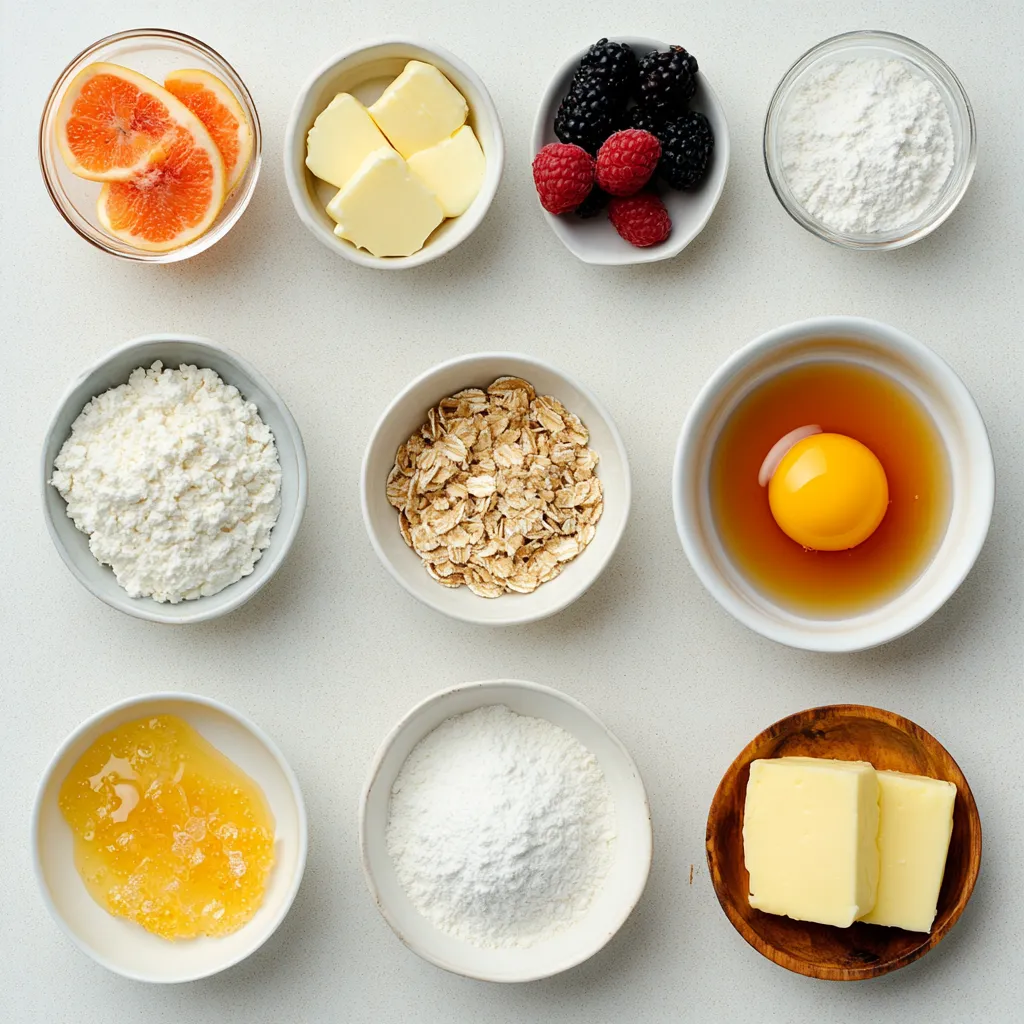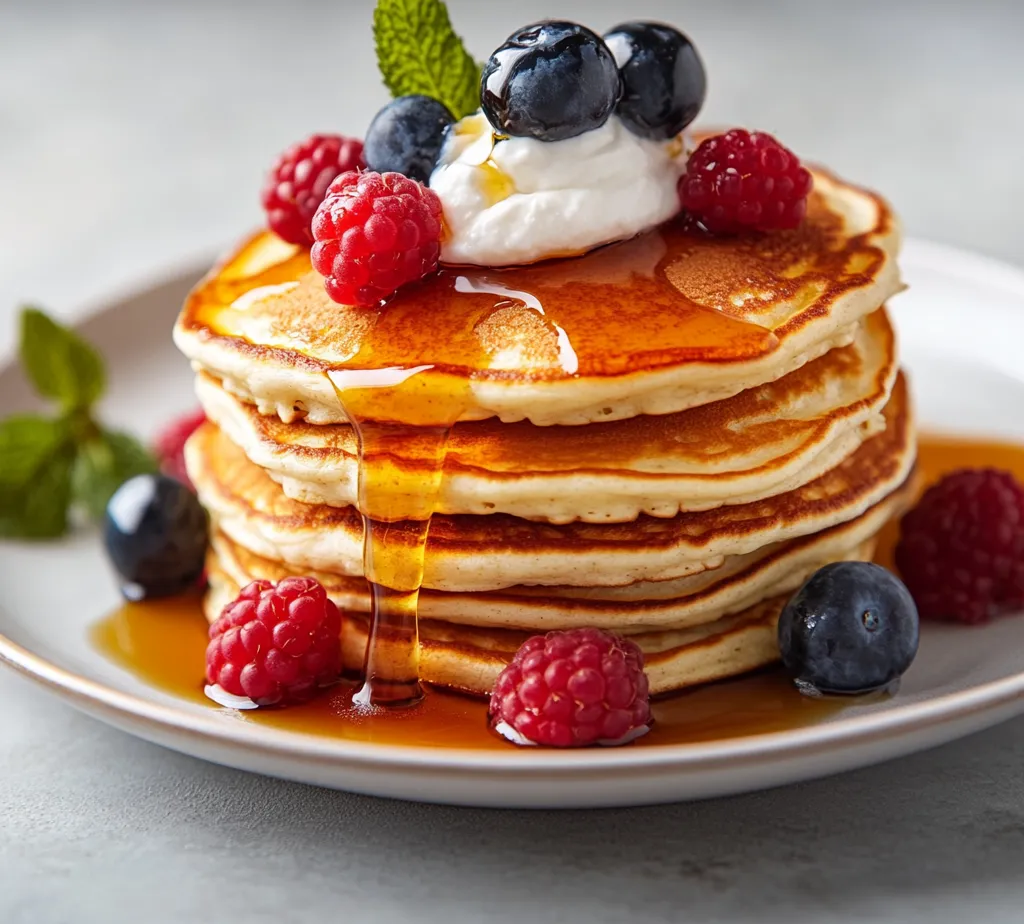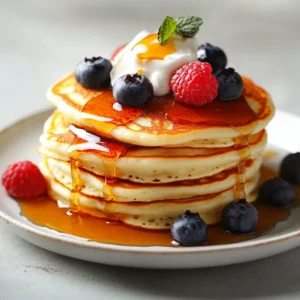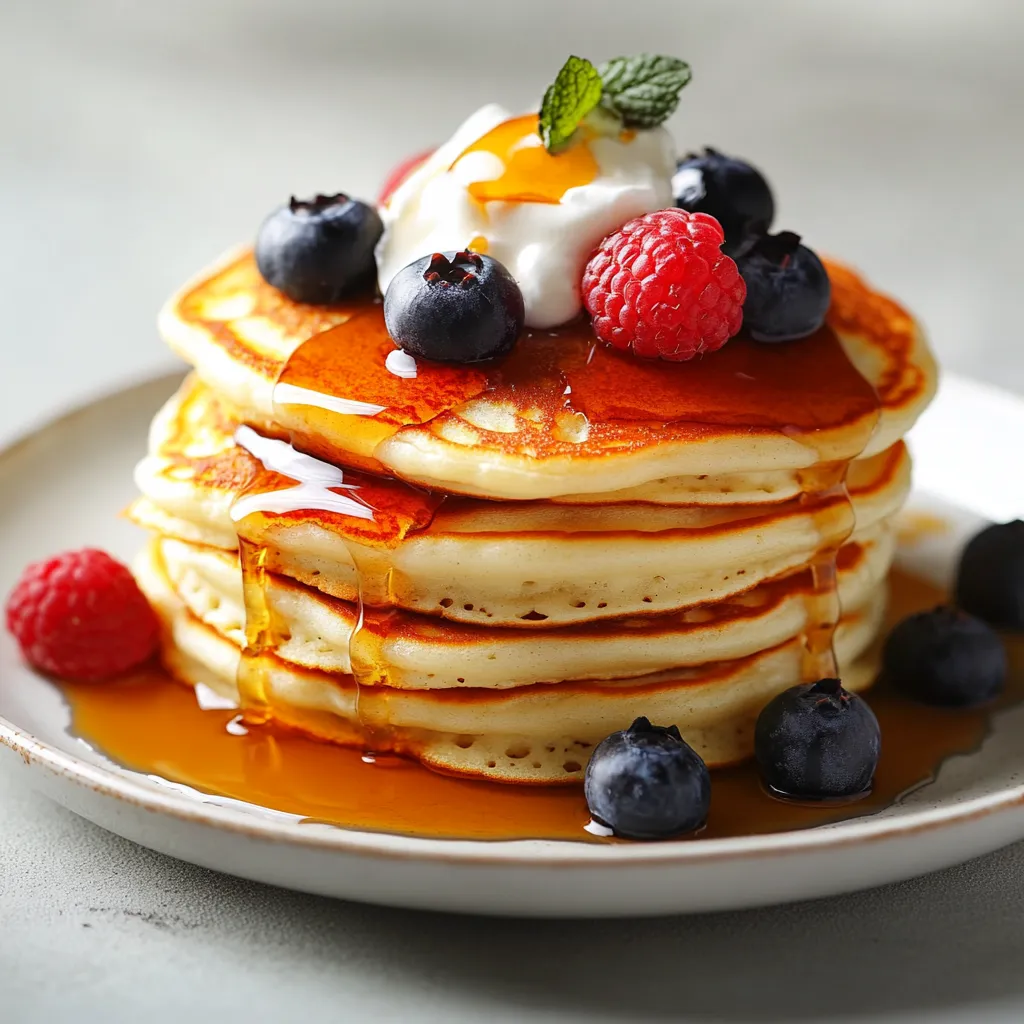Introduction
This fluffy gluten-free cottage cheese pancake recipe is a delightful twist on traditional pancakes, offering a protein-packed breakfast option that’s both satisfying and delicious. Perfect for anyone following a gluten-free diet, these pancakes blend the rich texture of cottage cheese with the light fluffiness of a classic pancake, making them ideal for a charming breakfast or brunch gathering. The inclusion of cottage cheese elevates both the flavor and the nutritional profile, ensuring every bite is a treat for the taste buds.
These pancakes are wonderfully versatile and can be served on various occasions. Whether it’s a leisurely weekend brunch with family or a quick weekday breakfast, they meet every need. Pair them with a drizzle of maple syrup, a handful of fresh fruits, or a dollop of yogurt to make your plate not only vibrant but also balanced and nutritious.
Recipe Overview
– Total Time: 20 minutes
– Prep Time: 10 minutes
– Cooking Time: 10 minutes
– Yield/Servings: 4 pancakes
– Difficulty: Not specified in the recipe
Ingredients
– 1 cup full-fat cottage cheese
– 3 large eggs
– 1/2 cup gluten-free all-purpose flour
– 1/2 teaspoon baking powder
– 1/4 teaspoon baking soda
– 1 tablespoon honey or maple syrup (optional for added sweetness)
– 1/4 teaspoon salt
– 1 teaspoon vanilla extract
– Butter or coconut oil for cooking
– Fresh fruit, syrup, or yogurt for serving (optional)

Instructions
1. In a mixing bowl, combine the cottage cheese, eggs, honey or maple syrup (if desired), and vanilla extract. Whisk thoroughly until the mixture is smooth and well blended.
2. In a separate bowl, whisk together the gluten-free all-purpose flour, baking powder, baking soda, and salt until evenly mixed.
3. Gradually incorporate the dry ingredients into the wet mixture, stirring gently until just combined. Be careful not to overmix; a few lumps in the batter are perfectly fine.
4. Preheat a non-stick skillet or griddle over medium heat. Add a small pat of butter or a drizzle of coconut oil to lightly coat the cooking surface.
5. For each pancake, pour approximately 1/4 cup of the batter onto the skillet. Cook for 2-3 minutes, or until bubbles appear on the surface and the edges begin to firm up.
6. Carefully flip the pancakes and continue cooking for another 2-3 minutes, or until they are golden brown and fully cooked through.
7. Once cooked, remove the pancakes from the skillet and keep them warm while you repeat the process with the remaining batter.
8. Serve the pancakes warm, topped with your choice of fresh fruit, syrup, or yogurt for a delightful breakfast or brunch experience.
Equipment Needed
Mixing Bowls
Using the right mixing bowls is essential for effectively combining both wet and dry ingredients. A large bowl for the wet mixture allows for ample space to whisk together ingredients like the cottage cheese and eggs, while a medium-sized bowl for the dry ingredients ensures that every component is evenly mixed without spilling. Having multiple bowls at hand helps streamline the mixing process and keeps your kitchen organized, making the pancake preparation more enjoyable.
Whisk
A whisk is a vital tool in creating a smooth batter for these pancakes. Its design allows for effective mixing, ensuring that the cottage cheese combines well with the eggs and other wet ingredients. If you use a whisk with a comfortable handle and suitable wire design, it also helps in avoiding clumps, leading to a lighter, airier pancake. For best results, incorporate a whisking motion that circulates air into the batter, contributing to the fluffiness of your pancakes.
Non-stick Skillet or Griddle
For cooking pancakes, a non-stick skillet or griddle is highly recommended as it minimizes the chance of the pancakes sticking to the cooking surface. This makes turning and flipping the pancakes less stressful and prevents them from falling apart. Additionally, non-stick surfaces help with even cooking, ensuring your pancakes are browned perfectly on the outside while remaining soft and fluffy on the inside. Ensure your skillet is preheated properly before pouring the batter to achieve optimal results.
Measuring Cups and Spoons
Accurate measurements are crucial when baking or cooking, especially for a recipe that relies on the balance of its ingredients for texture and flavor. Utilizing measuring cups for the cottage cheese, flour, and liquids, as well as measuring spoons for the baking powder, baking soda, and other components, guarantees that each pancake turns out perfectly. Precision in measuring helps maintain consistency in your pancakes, encouraging a satisfying result time and time again.
Preparing the Batter
Combining Wet Ingredients
A key step in making these fluffy pancakes is faithfully whisking together the wet ingredients. Start by placing the cottage cheese in the mixing bowl, followed by the eggs, sweetener, and vanilla extract. Using a whisk or fork, mix thoroughly until the blend is smooth. This is crucial as the cottage cheese needs to be well integrated, ensuring you do not have clumps of cheese in your final batter. The smoother the mixture, the more consistent the pancakes will be when cooked.
Mixing Dry Ingredients
In a separate bowl, the dry ingredients must be measured and mixed carefully. Begin with the gluten-free all-purpose flour, followed by the baking powder, baking soda, and salt. Whisk these ingredients together to ensure they are evenly combined, which will help the pancakes rise correctly. This mixing step is essential in ensuring that the leavening agents are distributed uniformly throughout the flour, leading to an even texture and fluffiness in the final product.
Merging Wet and Dry Ingredients
When it’s time to combine the wet and dry ingredients, do so gradually and with care. Add the flour mixture into the wet mixture in parts rather than all at once. Stir gently until just combined—overmixing can lead to dense pancakes. It’s perfectly fine to leave a few lumps; this mixture still needs to remain somewhat thick for optimal pancake texture. Enjoy this blending step, as it signifies the transition to the cooking phase where the deliciousness unfolds.
Cooking the Pancakes
Preheating the Skillet
Before you start pouring batter, preheating your skillet or griddle is imperative. Setting it over medium heat allows for an even cooking temperature, promoting that lovely golden brown color as the pancakes cook. Just before cooking, adding a small pat of butter or a drizzle of coconut oil enables the pancake to slide out effortlessly without sticking, adding flavor and richness to your final dish. Allow the skillet to heat adequately without overcrowding; cooking pancakes one or two at a time can yield the best results.
The anticipation builds as you prepare to cook what will surely be a breakfast hit, designed for enjoyment with friends or family. Each step in preparation is a vital part of creating this quick and easy meal that meets various dietary needs without compromising on taste.

The importance of medium heat for even cooking
Achieving the perfect texture in pancakes hinges significantly on maintaining the right cooking temperature. Medium heat is ideal as it allows the pancakes to cook through thoroughly without burning the outside. If the heat is too high, the surface may brown rapidly while leaving the inside undercooked, resulting in a heavy, unappetizing pancake. A well-preheated skillet not only aids in an even cook but also contributes to that desired golden crust which many pancake lovers crave.
Adding Cooking Fat
Butter or coconut oil plays a crucial role in the pancake-making process. The fat not only enhances the flavor but also prevents the batter from sticking to the pan. When melted, butter lends a rich, slightly nutty flavor to the pancakes, which can elevate the overall taste profile. Coconut oil, on the other hand, introduces a unique tropical element and is a fantastic option for those seeking a dairy-free alternative. Always ensure that you apply a thin layer of the fat to the skillet before pouring in the batter; this action creates a non-stick surface that permits easy flipping and prevents the pancakes from becoming greasy.
Pouring the Batter
For beautifully uniform pancakes, pouring the batter with consistency is key. Using a measuring cup or a ladle can provide a guideline to pour approximately 1/4 cup of batter per pancake, ensuring that each one cooks evenly and has a similar size. This aspect is vital, especially if you are serving the pancakes in a stack. If you desire smaller or larger pancakes, adjust the amount of batter accordingly while keeping track of the cooking time, as smaller pancakes may cook quicker, and larger ones might need extra time on the skillet.
Flipping the Pancakes
Signs of Doneness
Knowing when to flip the pancakes is an essential skill for achieving the ideal fluffiness. A good rule of thumb is to wait for the surface of the pancake to show bubbles that begin to burst, and for the edges to harden slightly, indicating that the bottom side is adequately cooked. If you flip too soon, the center may remain raw, while waiting too long can lead to browned or burnt pancakes.
Technique for Flipping
Flipping pancakes smoothly requires a bit of practice but can be perfected with these tips. Use a wide, flat spatula to lift the pancake gently from its center, ensuring that you have cut through any sticking points around the edges. With the spatula firmly yet delicately under the pancake, flip it in a swift motion to prevent it from breaking apart. If you’re new to flipping, try sliding the pancake onto the spatula first and then tilting the spatula to flip it back onto the skillet.
Serving Suggestions
Toppings Options
Pancakes can be a canvas for a plethora of delicious toppings that can cater to various tastes. Fresh fruit such as strawberries, blueberries, or sliced bananas pairs beautifully with the creamy base of the cottage cheese. A drizzle of syrup—be it classic maple syrup or a lighter honey—delivers sweetness, while yogurt can add a tangy contrast to the dish. Experimenting with different combinations like yogurt topped with nuts or fruits can elevate the hearty pancakes into a gourmet breakfast option.
Presentation Tips
The visual appeal of your pancakes can enhance the overall dining experience. Stack pancakes high for an impressive presentation, and dust with powdered sugar for an elegant finish. A vibrant mix of fresh berries on top can draw the eye and indicate the fresh flavors present in the dish. For an extra touch, use a colorful plate or serve them on a wooden board accompanied by syrup and yogurt in small bowls at the side for a brunch-style atmosphere.
Nutritional Benefits
Protein Content
Utilizing full-fat cottage cheese in this pancake recipe also brings along impressive nutritional benefits. Packed with protein, these pancakes offer a satisfying start to the day, contributing to muscle repair and satiety. The protein content helps maintain energy levels throughout the morning, making these pancakes an ideal choice for a post-workout breakfast or a filling brunch with friends.
Gluten-Free Advantage
For those adhering to gluten-free diets, these pancakes provide a comforting option without sacrificing taste or texture. Gluten-free all-purpose flour offers a blend of starches that emulate the properties of regular flour, creating a fluffy pancake that rivals traditional recipes. This makes them an excellent choice for individuals with gluten intolerances who wish to enjoy the classic pancake experience.
Customization Options
While the standard recipe is delicious as is, there is always room for customization to suit different dietary needs or personal preferences. Consider incorporating spices such as cinnamon or nutmeg for warmth, or extract flavors like almond or lemon to add a unique twist. These small tweaks can create entirely new pancake experiences without requiring drastic changes to the core recipe.
Storage Tips
Refrigerating Leftover Pancakes
Leftover pancakes can easily be stored in the refrigerator to maintain freshness. Allow the pancakes to cool completely before stacking them with parchment paper between layers to prevent sticking. Place them in an airtight container and they will stay fresh in the fridge for up to three days. This method preserves their texture, ensuring that they maintain their fluffy quality when reheated.
Reheating Methods
Reheating pancakes properly is crucial to avoid compromising their texture. The microwave is a quick solution: place a few pancakes on a microwave-safe plate and heat for 15-20 seconds until warmed through. For a more satisfying crispy exterior, consider reheating them in a skillet over low heat with a touch of butter or oil for a couple of minutes on each side. Alternatively, a toaster oven can also work well for a quick and effective reheating method.
Variations and Add-Ins
Flavor Enhancements
To create exciting variations of the basic pancake recipe, adding flavor enhancers can provide a delightful twist. Mixing in spices like cinnamon, allspice, or ginger can impart a warm and comforting flavor. Vanilla or almond extracts can also be added to the batter for an additional fragrant note.
Dietary Adjustments
While the recipe is quite accommodating, modifications can be made to fit different dietary requirements. To make these pancakes vegan, replace the eggs with flaxseed meal or chia seeds combined with water as a binding agent. For dairy-free options, similarly, opt for a plant-based cottage cheese substitute that aligns with your dietary goals.
These fluffy gluten-free cottage cheese pancakes provide a delightful breakfast experience with their light, airy texture and rich flavor. With a quick total cooking time and a few simple ingredients, they are perfect for busy mornings or leisurely brunches alike. Enjoy them warm with your favorite toppings for a satisfying meal.

Fluffy Gluten-Free Cottage Cheese Pancakes Recipe
Ingredients
- 1 cup full-fat cottage cheese
- 3 large eggs
- ½ cup gluten-free all-purpose flour
- ½ teaspoon baking powder
- ¼ teaspoon baking soda
- 1 tablespoon honey or maple syrup optional
- ¼ teaspoon salt
- 1 teaspoon vanilla extract
- Butter or coconut oil for cooking
- Fresh fruit syrup, or yogurt for serving (optional)
Instructions
- In a mixing bowl, combine the cottage cheese, eggs, honey or maple syrup, and vanilla extract. Whisk until smooth.
- In a separate bowl, whisk together the gluten-free flour, baking powder, baking soda, and salt.
- Gradually mix the dry ingredients into the wet mixture until just combined.
- Preheat a non-stick skillet over medium heat and add butter or coconut oil.
- Pour approximately ¼ cup of batter onto the skillet for each pancake.
- Cook for 2-3 minutes until bubbles appear and edges firm up.
- Flip the pancakes and cook for another 2-3 minutes until golden brown.
- Remove pancakes from the skillet and keep warm while cooking the remaining batter.
- Serve warm with fresh fruit, syrup, or yogurt.

